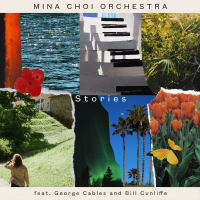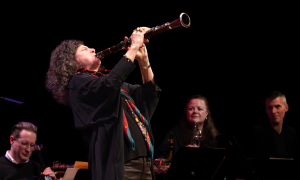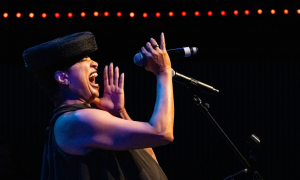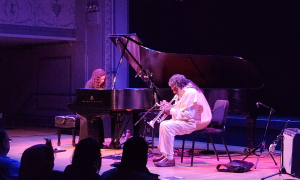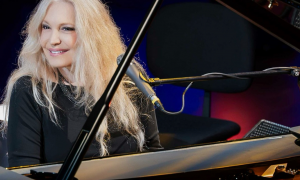Home » Jazz Articles » Live Review » Festival International de Jazz de Montréal 2019
Festival International de Jazz de Montréal 2019
Antonio Sanchez & Migration / Ravi Coltrane Quartet
Théâtre Maisonneuve
June 30, 2019, 8:00PM
The Festival International de Jazz de Montréal has a long history of great double bills, but in pairing drummer Antonio Sanchez and his Migration group with saxophonist Ravi Coltrane's Quartet, the festival may well have outdone itself.
It's hard to believe that both Sanchez and Coltrane have been around for over twenty years (in Coltrane's case, thirty). The Mexican-born/American resident Sanchez first came to attention in the late '90s with pianists Marcus Roberts and Danilo Pérez, as well as with saxophonist David Sanchez (no relation). But it was in 2002, when the drummer was recruited by guitarist Pat Metheny for Pat Metheny Group's Speaking of Now (Warner Bros)—the first of nine recordings and countless tour dates over the next fifteen years with the guitarist—that Sanchez achieved much broader (and well deserved) international acclaim.
Sanchez's exposure with Metheny, and subsequent work with artists including Gary Burton, Enrico Pieranunzi, Donny McCaslin and Miguel Zenon ultimately led to Sanchez releasing the first of eight albums for the Italian Cam Jazz label (including three with his Migration band, beginning with 2013's New Life), where, in addition to being a powerhouse drummer, Sanchez began to emerged as a captivating composer and conceptualist of no small significance, and one who clearly believes in music's transformative power.
In addition to bassist Matt Brewer and saxophonists David Binney and Donny McCaslin, New Life also featured New York staple but ever-undervalued pianist John Escreet, alongside an impressive singer/electronic manipulator, Thana Alexa. Despite other personnel moving in and out of Migration, including guitarist Adam Rogers and saxophonist Seamus Blake, it was Escreet and Alexa who have become Migration's most consistent members, also contributing to 2015's The Meridian Suite and, most recently, 2018's Lines in the Sand.
Lines in the Sand also includes Chase Baird, and it was the saxophonist/EWI player who, alongside Sanchez, Thana, Escreet and relative Migration newcomer (but nevertheless another fixture on the NYC scene), bassist Orlando Fleming, formed the drummer's current Migration lineup, making its first-ever FIJM appearance. Delivering a set drawn entirely from Lines in the Sand, Sanchez's Migration performance demonstrated music's potential for socio- political change.
Everyone in Migration is a leader in his/her own right, with Alexa and Baird both relative newcomers. Still, despite both Escreet and Fleming being busy players on the New York scene, literally everyone in Migration, with the exception of the higher-profile Sanchez, are well deserving of broader recognition, with this band representing its members' most eminently visible gig. As young a group of players as Sanchez (the oldest, at 47) has recruited for the current Migration, ranging from 31 to 42, they all proved to be potent, creative and undeniable musical forces with which to be reckoned, both individually and collectively.
As on the album, the set opened with "Travesia Intro," a prerecorded collage of sirens and the sounds of children crying, people screaming and questions being asked as they're being arrested and detained by ICE agents ("Do you have a warrant? Are you with ICE? This is wrong," and more), the band walked onstage in relative darkness. When "Travesia Intro" suddenly halted, the band launched into a thirty-minute version of Lines in the Sand's multi-part "Travesia Suite." An episodic (and epic) journey through a myriad of stylistic feels that nevertheless centered on Sanchez's fluid polyrhythmic playing, it was a lengthy suite also based upon Escreet's simple, repetitive Fender Rhodes pattern, and ultimately traversing considerable dynamic terrain, filled with complex compositional constructs that also left plenty of solo space for everyone in the band.
Alexa, in addition to demonstrating a rare ability to both execute broad intervallic leaps with absolute precession and navigate Sanchez's often-times knotty, serpentine (yet still, somehow, eminently lyrical) themes, expanded upon them with her seamless integration of electronics, controlled from a series of devices on a stand before her. Not unlike Sanchez's ex-employer, Pat Metheny, who did a lot of writing for wordless voice, Alexa was largely used in a similar fashion, though she did contribute topical prose to the relatively brief "Home" and narrated two different sets of poetry during the set (and album)-closing "Lines in the Sand Part 1 and 2." In her solo features, she demonstrated even greater control over dynamics and melodic constructions, with a broad range covering huskier lower registers to purer, more powerful leaps into the stratosphere.
Whether contributing repetitive, minimalist-informed patterns or soloing with the kind of expansive harmonic constructions and compositional focus he's also brought to his own albums, including Don't Fight the Inevitable (Mythology, 2010) and, more recently, The Unknown (Sunnyside, 2016), Escreet proved as distinctive as ever, moving fluidly between Fender Rhodes and grand piano, and from spare lines to more complex phrases and detailed, sophisticated voicings.
Fleming didn't just anchor the group throughout, whether on electric or double bass; he was also used as a melodic foil throughout, one example being the simple, long notes at the start of "Long Road," which began with Escreet alone, but subsequently joined by Fleming and Alexa, as the spacious introduction gradually moved into a more delicate ensemble piece. Fleming also contributed a number of impressive solos throughout the set, mostly on electric bass but always demonstrating an allegiance to the needs of the material rather than forcing the material to become secondary to his own contributions. He may still largely be known for his double bass work but here, in particular towards the end of "Lines in the Sand," his slapping and popping bass acted as a firm anchor for Escreet's final solo of the set.
Baird was an impressive saxophonist, but it was his work on EWI (electronic wind instrument) that was most affecting, even adopting a tone similar to Metheny's signature Roland GR-300 "trumpet" patch near the end of "Lines in the Sand." It's odd, in fact, that EWI never really took off as an instrument, though it was an important instrument for fellow reed men like the late Michael Brecker. Still, Baird took full advantage of its sonic possibilities throughout the set, often doubling or harmonizing with Alexa's similarly remarkable articulations of Sanchez's labyrinthine yet still largely memorable melodies.
The exhilarating combination of EWI and electronically enhanced voice in the first climatic build-up during "Bad Hombres Y Mujeres" rendered it the set's heaviest tune, with Fleming's thundering electric bass blending with Escreet's heavily distorted Fender Rhodes. Both bolstered Sanchez's frenetic kit work, and the remarkably high-speed, high-octane lines doubled by Alexa and Baird. Based upon one of the rhythmic themes on Sanchez's brave solo drum record, 2017's Bad Hombre (Cam Jazz), it was similarly captivating, and one of the set's many clear milestones.
Beyond being one of the most distinctive drummers of his generation, Sanchez has evolved, since his first solo album for Cam Jazz, 2007's presciently titled Migration, as a composer of note. There's little doubt that his lengthy tenure with Metheny has influenced the drummer's often complex, often episodic and multi-part writing. But his own experiences, musical and otherwise, have contributed to the complexion of his writing, and so if there are traces of Metheny to be found in Sanchez's compositions, they're just that: traces.
There were plenty of other touchstones, including the thundering rock rhythms that concluded "Lines in the Sand Part 2" and Sanchez's entire FIJM performance, which anchored Escreet's overdriven, ring-modulated solo halfway through its two parts. And, for a drummer-led band, Sanchez may have limited his own solo space, but when he did, as he did right near the end of the set, it was focused, compositionally oriented and utterly thrilling,
Furthermore, Sanchez's music is as tightly tied to his experience as a Mexican expat living in the USA since 1993, and who has held dual citizenship for the past three years: "Perfect timing," he quipped during one of his introductions. "Now they can arrest me but they can't deport me." It was a clear statement about the racial profiling that has increased significantly since Trump took office. Sanchez's lengthy but important introductions at a couple of points during the set helped clarify the life and music resonances and influences that have driven his writing.
Sanchez described going to a "jam session festival" that took place at the USA/Mexico border of Tijuana and San Diego, with people coming from around the world and, setting up on both sides of the border, dancing and singing the same song just inches from the rusted fence that starts at the Pacific and runs to the Gulf of Mexico, with the fence going right out into the water. It's that image, in fact, with a lone young woman on one side, that became Lines in the Sand's cover. Sanchez was writing the music for the album when he encountered a poetry contest; so moved by two of them that he located the authors and had them read their own prose for the album's closing two-part title track, with Paola Gonzalez and Karla Gutierrez contributing prose to "Lines in the Sand Part 1," and Jonathan Mendoza narrating his poetry during "Lines in the Sand Part 2." In performance, Alexa assumed both roles.
Sanchez made clear just how grateful he is for the opportunities he's been afforded since moving to the USA. At the same time, however, he clearly never forgets the plight of his many abused Mexican brothers and sisters, in addition to cousins from Guatemala, Ecuador and Honduras,relying upon his music to articulate their struggles in a most positive and compelling fashion. Music can, indeed, be an instrument for social awareness and, even furthermore, societal change. With Sanchez's Migration delivering increasingly strong statements on albums like Lines in the Sand, the drummer/composer has clearly found a way to reconcile his own experiences and articulate them, both lyrically and musically, in a way that reached his audience directly, as it most certainly did during his 90-minute set at Montréal's Théâtre Maisonneuve (one of Place des Arts' best rooms), to a near-capacity crowd.
Following a short break, Ravi Coltrane took to the stage at Théâtre Maisonneuve with a quartet that couldn't have been more different from the group he last brought to FIJM in 2013. Unlike his recordings since 2005, beginning with In Flux (Savoy Jazz, 2005) and which almost consistently featured a quartet with pianist Luis Perdomo, bassist Drew Gress and drummer E.J. Strickland, Coltrane's 2013 show employed a thoroughly commanding guitar-centric configuration, with six-stringer Adam Rogers joining double bassist Dezron Douglas and drummer Johnathan Blake.
He hasn't released an album under his own name since 2012 but, in addition to producing Both Directions at Once: The Lost Album (Impulse!, 2018), the unexpected but extraordinary archival find from the late John Coltrane, the 53 year-old saxophonist (who has now outlived his legendary, groundbreaking saxophonist father by thirteen years) has appeared on other albums, including two ECM recordings: drummer Jack DeJohnette's In Movement (2016); and trumpeter Ralph Alessi's Imaginary Friends (2019). Coltrane's most recent Spirit Fiction (Blue Note, 2012) again featured, amongst others, Perdomo, Gress and Strickland, but for his 2019 performance the saxophonist brought rising Cuban star pianist, David Virelles, alongside the returning Dezron Douglas and Johnathan Blake.
Surrounding himself, again, by a group of leaders in their own rights, Coltrane's performance was far more left-of-center than his 2013 show, which took place in a different Place des Arts venue, the smaller Théâtre Jean-Duceppe. Virelles, now in his mid-thirties, has emerged on ECM with a series of solo albums including 2014's Mbókò, after appearing on albums for the label by artists including Chris Potter (2013's The Sirens) and the late Tomasz Stańko (2013's Wislawa). While it's true that the music of his native Cuba persistently informs what Virelles achieves, it's always through a refracting prism of freer, more outside American jazz concerns and a strong compositional sense.
Douglas may have a relatively diminutive discography as a leader, but he's been an in-demand bassist since the middle of the new millennium's first decade, recording and/or performing with artists Including Willie Jones III, Steve Davis, Cyrus Chestnut and George Cables. As capable of a firm swing as he is more intimate work in a freer context, Douglas not only proved a terrific anchor for Coltrane's quartet, but a particularly responsive partner for Blake, who first emerged, just a few years before Douglas, as a member of the ongoing Mingus Big Band.
Blake has also recorded and/or toured with seminal jazz artists like Tom Harrell (for five HighNote releases, including Prana Dance and 2011's Time of the Sun), Dr. Lonnie Smith and Kenny Barron. Still, it's his slowly expanding discography as a leader that's most significant, beginning with the larger-casted The Eleventh Hour (Sunnyside) and leading to the more intimate saxophone trio of Trion (Giant Step Arts, 2019).
In his own work, Blake draws upon the greatest pillars of the jazz tradition, from ambling swing to free-bop intimations. He brought the same breath of experience to Coltrane's show, while continuing the largely winning streak of drummers who've graced various stages at the 40th FIJM, including Steve Gadd, Jarle Vespestad and Antonio Sanchez. For such a big guy, Blake plays the smallest of kits. With what looks like a 16" bass drum (maybe even smaller), Blake's snare, rack and floor toms are at roughly the same heights, not unlike Bill Bruford's larger but similarly vertical-consistent kit with his second, acoustic version of Earthworks documented in the recently released Earthworks Complete (Summerfold, 2019) box set. But unlike Bruford, even Blake's cymbals and high hat were at nearly the same level.
But unlike the stage setup that, in 2013, was similarly intimate, with the musicians positioned closely together, Coltrane's 2019 quartet was even more tightly placed, with Virelles on stage left, followed by, moving left to right, Coltrane, Douglas and Blake, with the pianist and drummer both facing inwards, in order to ensure proper eye contact could be maintained throughout the ninety minute set.
If Coltrane has absorbed and reflected anything of his father's music (and he has, but not in an overt fashion), it's in the more relentlessly unfettered approach his father adopted, whether playing entirely free, tumultuous rubato, or a more rhythm-heavy manner. Nothing from the setlist was announced, with the group sometimes bringing the music to a definitive conclusion, at other times segueing seamlessly into the next piece.
Coltrane brought a broad array of horns to the date. Not only did he use the more standard, muscular tenor and sweeter soprano saxophones (the latter, played far less nasally than his father); he also played what appeared to be that smallest of the saxophone family, the piccolo or sopranissimo saxophone. It was difficult to ascertain if Coltrane was, indeed, using the more dulcet sopranissimo rather then an Eb sopranino, which is also rather small, but slightly larger than the 12" sopranissimo. Still, the sopranissimo is, like its soprano and tenor brethren, a Bb horn, albeit one pitched an octave higher than the soprano and two above the tenor, making it the more likely instrument.
The set opened with a drum solo, a stunning demonstration of Blake's ability to combine effortless instrumental mastery with an unmistakable approach to shaping improvisations that were possessed of vivid spontaneous form. Coltrane joined Blake in duet on sopranissimo, reminiscent of the kinds of fiery interactions his father would engage in with either Elvin Jones or Rashied Ali, but this was a far more contemporary approach to empathic, dual-instrument extemporaneous interplay.
Coltrane then took over, as the entire band coalesced around him, ultimately leading to a piano solo bolstered by a hard-walking Douglas and ferociously swinging Blake. This was a band clearly firing on all cylinders from the very start, as the swing dissolved, once again, into the tempestuous maelstrom that seemed to always bubble, just beneath the music, whether it was with time and changes or in a far freer context where the collective size of the quartet's ears was in constant evidence.
In contrast to Sanchez's set, with writing that managed to straddle that fine line between greater freedom and complex compositional form, Coltrane's performance was even more challenging and more exacting in its cerebral nature. The majority of Sanchez's music was eminently accessible, even if what was going on under the hood was relentlessly demanding. Coltrane, on the other hand, largely dispensed with any intentions of accessibility. Not that his music left the enthusiastic crowd behind—far from it. But with the more open-ended variations that defined virtually all of Coltrane's music and the liberated, reckless abandon of his stellar quartet, it was also more decidedly rarefied and intellectual than Sanchez's more visceral aesthetic tendencies.
All told, it was an exceptional pairing, with each group travelling across considerably different terrain while, at the same time, possessed of certain markers that rendered them ideal bill-mates.
Christian Scott aTunde Adjuah
Monument-National
July 1, 2019, 8:00PM
For the last show covered at the Festival International de Jazz de Montréal, first: a disclosure. When covering one of the earliest performances by Sound Prints at the 2014 TD Ottawa Jazz Festival, leaders Dave Douglas and Joe Lovano were joined, alongside drummer Joey Baron and bassist Linda May Han Oh, by a very young pianist named Lawrence Fields. While seeming to demonstrate plenty of promise, the review was less than kind to him, suggesting that he may not have been ready for a band with such esteemed players.
Wrong. Or, at least, more than a bit unfair because, just a few short years later, Fields showed up at FIJM's 40th edition, playing with Christian Scott aTunde Adjuah. Wrong, because not only was the still seemingly shy Fields (now, seven years later, 34) the perfect, stylistically expansive choice for the trumpeter, composer and bandleader's current group; he was, quite simply, an absolute standout, whether playing a sampled grand piano, Fender Rhodes or synth. With touchstones including a clear appreciation of the jazz tradition and classical tinges that imbued his work (most notably, 20th century minimalism), Fields also contributed a myriad of styles, colors, textures and timbres to a set that spoke to a worldwide confluence of influences that also included western modernism, profound Africanism and hints of eastern harmonies. Whether soloing with finesse and construction or creating a context over which his band mates could soar, Lawrence Fields was the real deal.
Sure, such a player (especially one like Fields) would inevitably evolve and improve over time; but watching him throughout Adjuah's 90-minute set, it was hard to escape the feeling that, at his 2012 Sound Prints Ottawa show, the problem was most certainly not of his making; instead, it's become most certainly clear that it lay with the reviewer. During his introduction of the band, Adjuah enthused about Fields: "He can find a way to marry anything to jazz. To be able to do that you have to care about other peoples' cultures...and place people first. Laurence cares...I prefer, rather than introducing him as my pianist, to introduce him as: my friend."
But Fields was just one of Adjuah's many astute choices for his quintet. Logan Richardson is a clear rising star, with the nearly forty year-old alto saxophonist's recent blues People (Ropeadope, 2018) receiving some much-deserved attention. Of Richardson, Adjuah said: "His 2007 album [Cerebral Flow (Fresh Sound New Talent)] made clear that everyone was on a great page...but honestly, it was the wrong page." Throughout the set, Richardson supported Adjuah's honest and heartfelt truth about his fellow hornist on the front line.
Bassist Kris Funn has been playing with the New Orleans-born/raised nephew of saxophonist Donald Harrison since before the trumpeter first adopted his African name, going even further back than Adjuah's powerhouse performance at the 2010 TD Ottawa Jazz Festival. Funn continues to be a double bassist capable of providing a firm rhythmic anchor when needed, a portentous soloist when called upon, and a contrapuntal partner when the song demanded it.
Adjuah recalled when he first asked Funn to join his band, describing how they'd just played for five hours, and so the trumpeter asked the bassist if he'd like to join his band. "No," Funn apparently said. So, Adjuah went to the bar for some "liquid courage," returned and asked Funn, again, if he'd join the trumpeter's band. "Fuck, no," was Funn's response. Adjuah then boarded his train, from Washington, DC back to New York City, again running into Funn, who said, "Where'd you go? I just wanted to see your face!" And so, Funn joined the band and has been with Adjuah ever since.
Behind the kit, Corey Fonville has become one of his generation's more influential drummers. In addition to working with Adjuah, he plays in Butcher Brown (who'll be appearing at FIJM the following evening), described on its website as a band that "takes careful note of the history and legacy of jazz and throws caution to the wind with wanton abandon. Garage punk jazz funk on the low end of the dial gives way to delicate and elegant compositions as the band shows off without trying. These are not just players, these are musicians."
Adjuah enthused about knowing them drummer since he was fifteen, and about his band, Butcher Brown, which has released seven albums since 2014, though Fonville has also been on every Adjuah recording since 2015's Stretch Music (the term that Adjuah now prefers over "jazz" to describe his music). That means, including 2017's sprawling Emancipation Procrastination trilogy and this year's equally ambitious Ancestral Recall, that the drummer has also played on five of the trumpeter's recordings in the past four years.
Scott introduced percussionist Weedie Braimah, at his quintet's incendiary Monument-National FIJM performance, as "the new sound of the djembe, a man who understand language and folkloric traditions; where telling stories represents the truth and actual history of this music—an extension of West African music." While only taking one solo, Braimah was a veritable force of nature throughout the set, blending his unequivocal cross-pollination from across many genres and stylistic markers into Adjuah's pan-cultural stew, a stylistic purview of jazz that looked simultaneously backwards and forwards.
Whether blending hip hop with a profound understanding of Adjuah's innate African and African/American cultures, or rendering crystal clear the trumpeter's seriously deep appreciation of the jazz tradition, the twice Edison-awarded/twice Grammy-nominated artist has managed to conjoin growing up and studying with his uncle, saxophonist Donald Harrison, attending the New Orleans Center for Creative Arts, and subsequently ending up at Boston's Berklee College of Music.
Now in his mid-thirties, Adjuah, always an extremely bright and articulate man, clearly proved that he was about far more than the music (as if the music weren't enough). In his various introductions at a FIJM performance that drew upon music from his recent album as well as a positively nuclear look at Herbie Hancock's "Eye of the Hurricane," first heard on the pianist's classic Maiden Voyage (Blue Note, 1966), the man who was once a spyboy for his elder grandfather, Donald Harrision, Sr., spoke of many things, ranging from his hopes for music to a clear love and respect for his grandfather, who was once chief of four tribes (Creole Wild West, Cherokee Braves, White Eagles and Guardians of the Flame), a mantle since inherited bu Adjuah.
"It's time for re-evaluation, having recently crossed into second century of jazz," Adjuah said; "I am also re-evaluating the relationship between musicians and you [the audience]. Have the best time you possibly can...music is a positive energy but...you need to feel it. These stories are your stories too, so feel free to enjoy them."
In his final introduction to an encore ("The Last Chieftain") that the massively enthusiastic Montréal crowd simply would not do without: "This song means more to me than the other songs. It's a song I was born out of." First heard on Stretch Music, the quintet's version was significantly altered, given the original featured one of the founding members of Adjuah's first touring band (and, as the trumpeter described him, "the musical director"), guitarist Matthew Stevens. A fluidly bolstered melody supported by Fields' powerfully minimalist lines, it opened up into a solo for Adjuah that was the trumpeter's most potent example of his instrumental mastery and strength, as his carefully constructed yet ever-emotional lines gradually ascended into the stratosphere with a surprisingly full-bodied tone, even as he reached ever higher into the near-impossible.
"As a little boy," Scott explained in his introduction to the song, "my grandad Donald Harrison, Sr. was the chief of four different tribes; three years ago I became chief. I woke up that morning with a forgotten memory from childhood. Grandfather would dine in, and then he would take all the food from house. It took me five years to ask why, when he made me get a big canvas bag, go to two aunts, an uncle and mother, and fill up the bag with food. Then I met him on a corner in New Orleans. As I walked into the different wards, people lined up: nobody had eaten or bathed. Finally, I saw it, with people taking food one by one; you could see the emotional reality. Families where the husband had two jobs, the wife had one and it was still not enough to feed their kids.
"We never talk about how expensive it is to be poor," Adjuah concluded.
But beyond such philosophical, existential and practical life matters, Adjuah's performance was a highlight of this year's festival, encouraging everyone in the near-capacity crowd to respond to the music in whatever way felt right to them. Richardson and Adjuah made for a potent front line, both inventive soloists who, nevertheless, were clearly focused on creating the most evocative engagements together—and with the rest of the band. Surprisingly (or, perhaps, not), Scott was a beyond egalitarian bandleader, affording his band mates more improvisational freedom than he actually took himself...though when he did solo, whether on the angularly shaped trumpet inspired by the late Dizzy Gillespie or a similarly designed flugelhorn, it was always a clearly focused statement where not a single note was wasted and, instead, every note counted.
Richardson took a number of similarly eloquent and meaningful solos throughout the performance, but it was his extended series of trade-offs with Adjuah during the group's fiercely propulsive, tumultuously driven "Eye of the Hurricane" that were the true highlights amongst the many that occurred throughout the set, the altoist and trumpeter egging each other on with increasingly tightening passages until they came together in absolutely exhilarating unison, the two soloing in tandem with energy, virtuosity and taste.
Fields, whose minimalist tendencies were amongst his most notable contributions to the overall complexion of the quintet, delivered a number of thoughtful yet evocative (and provocative) solos, positioning the keyboardist, just a couple years younger than Adjuah, as one of his generation's pianists for whom to be on the lookout. Funn, too, delivered as a firm anchor for the group, whether supporting a modal vamp driven with hip hop-inspired rhythms or fiercely swinging periods of reckless abandon, or as an affecting soloist. With a deep, woody tone felt deep in the gut, Funn's choices were as note-perfect as they were texturally rich and imaginatively shaped.
There are musicians for whom the music they make is, indeed, a political statement: reflections of the times they live in, where using the music they make says what, perhaps, they could not articulate any other way. The erudite Scott, however, not only made music that spoke to his many concerns about the world in which he (and we) live. Just a look at some of the titles of his compositions—"Liberation Over Gangsterism," "Gerrymandering Game," "Unrigging November," "Ritual (Rise of Chief Adjuah," "Ancestral Recall"—and it's impossible not to be affected by Adjuah's music...and the clear hopes that pervade his thoughts.
It was an absolutely staggering, mind-blowing show that demonstrated the clear potential for music as an agent of change. Christian Scott aTunde Adjuah may have plenty to say, both in his words and his music; but his message is one that should reach out and touch any who encounter it. Those in attendance at Monument-National may have walked away with different interpretations or feelings about what they'd just seen and heard, but it's hard to imagine anyone leaving the show without a positive impression of Adjuah's clear and distinct musical message.
And with that, the first half of the 40th edition the Festival International de Jazz de Montréal concludes. Five nights, four exceptional performances and one that was, unfortunately, surprisingly disappointing. But no matter what the reputation of the musicians whose performances made the cut in choosing who to see, it's a reality that live performances are always something of a crapshoot. With a solid eight out of ten for five nights at the world's biggest jazz festival, and one where the media department makes every journalist feel like he/she is the only person covering the event?
It's impossible not to appreciate the treatment; nor is it possible to walk away from the festival, as has been the case nearly every year since 2005, without looking forward to what the next edition will bring.
Photo Credit: Dave Kaufman
Tags
PREVIOUS / NEXT
Antonio Sanchez Concerts
Support All About Jazz
 All About Jazz has been a pillar of jazz since 1995, championing it as an art form and, more importantly, supporting the musicians who make it. Our enduring commitment has made "AAJ" one of the most culturally important websites of its kind, read by hundreds of thousands of fans, musicians and industry figures every month.
All About Jazz has been a pillar of jazz since 1995, championing it as an art form and, more importantly, supporting the musicians who make it. Our enduring commitment has made "AAJ" one of the most culturally important websites of its kind, read by hundreds of thousands of fans, musicians and industry figures every month.














